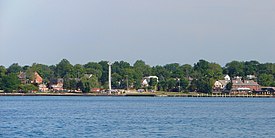
St. Clair County is a county located in the U.S. state of Michigan and bordering the west bank of the St. Clair River. As of the 2020 census, the population was 160,383. It is the 13th-most populous county in the state. The county seat is Port Huron, located at the north end of the St. Clair River at Lake Huron. The county was created September 10, 1820, and its government was organized in 1821. It is located northeast of Detroit and is included within the Detroit–Warren–Dearborn Metropolitan Statistical Area by the Office of Management and Budget. It is also consider by the State of Michigan to be a part of The Thumb, a peninsula that surrounded by Lake Huron in the east-central area of the state. This area is sometimes dubbed the Blue Water Area.

Sanilac County is a county located in the Thumb region of the U.S. state of Michigan. As of the 2020 Census, the population was 40,611. The county seat is Sandusky. The county was created on September 10, 1822, and was fully organized on December 31, 1849. Sanilac County is considered to be part of the Thumb of Michigan, a subregion of the Flint/Tri-Cities. Sanilac County enjoys seasonal tourism in towns such as Lexington, Port Sanilac, and Carsonville. Sanilac County is economically attached to St. Clair County and Huron County and is largely composed of nearly flat areas of rich soil.

Iron River is a city in Iron County in the U.S. state of Michigan. As of the 2010 census, the city population was 3,029. The city is situated at the southeast corner of Iron River Township, but is administratively autonomous. Iron River is the birthplace and home of four-time US Olympian and 2022 gold medalist Nick Baumgartner.

Harrison Charter Township is a charter township of Macomb County in the U.S. state of Michigan. The population was 24,314 at the 2020 census.
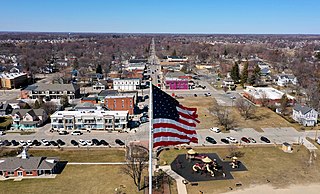
New Baltimore is a city in Macomb County in the U.S. state of Michigan. The population was 12,117 at the 2020 census. New Baltimore is a northern suburb of Metro Detroit and is located along the northern shores of Lake St. Clair.

St. Clair Shores is a suburban city bordering Lake St. Clair in Macomb County of the U.S. state of Michigan. It forms a part of the Metro Detroit area, and is located about 13 miles (21 km) northeast of downtown Detroit. Its population was 59,715 at the 2010 census.

The City of Orchard Lake Village is a city in Oakland County in the U.S. state of Michigan. A northern suburb of Detroit, Orchard Lake Village is located roughly 27 miles (43.5 km) from downtown Detroit, and about 3 miles (4.8 km) southwest of Pontiac. The city is mostly surrounded by West Bloomfield Township, with a small northeast border with Keego Harbor. As of the 2010 census, the city had a population of 2,375.

Algonac is a city in St. Clair County of the U.S. state of Michigan. The population was 4,196 at the 2020 census.

Clay Township is a civil township of St. Clair County in the U.S. state of Michigan. The population was 9,066 at the 2010 Census.

Cottrellville Township is a civil township of St. Clair County in the U.S. state of Michigan. The population was 3,559 at the 2010 Census.

Kimball Township is a civil township of St. Clair County in the U.S. state of Michigan. As of the 2010 census, the township population was 9,358.

Marine City is a city in St. Clair County in the U.S. state of Michigan. Located on the west bank of the St. Clair River, it is one of the cities in the River District north of Detroit and south of Lake Huron. In the late 19th century, it was a major center of wooden shipbuilding and lumber processing.
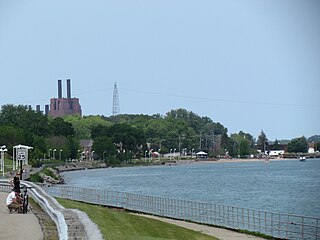
42°54′45″N82°29′13″W
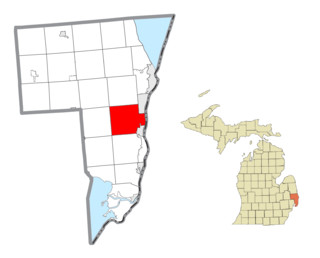
St. Clair Township is a civil township of St. Clair County in the U.S. state of Michigan. The population was 6,817 at the 2010 Census. The city of St. Clair is located near the southeast corner of the township.
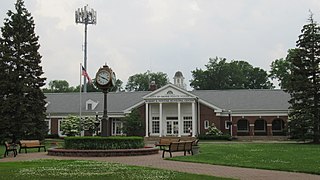
Grosse Pointe Woods is a city in Wayne County in the U.S. state of Michigan. The population was 16,135 at the 2010 census.

Kenockee Township is a civil township of St. Clair County in the U.S. state of Michigan. The population was 2,470 at the 2010 Census.

Sauk Centre is a city in Stearns County, Minnesota, United States. The population was 4,555 at the 2020 census. Sauk Centre is part of the St. Cloud Metropolitan Statistical Area.

Grosse Pointe Shores is a city in Macomb and Wayne County in the U.S. state of Michigan. The population was 3,008 at the 2010 census.

Memphis is a city that straddles the border between Macomb and St. Clair counties in the U.S. state of Michigan. The population was 1,084 at the 2020 census.

Lake St. Clair is a freshwater lake that lies between the Canadian province of Ontario and the U.S. state of Michigan. It was named in 1679 by French Catholic explorers after Saint Clare of Assisi, on whose feast day they first saw the lake.
